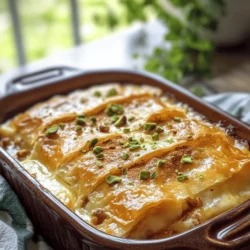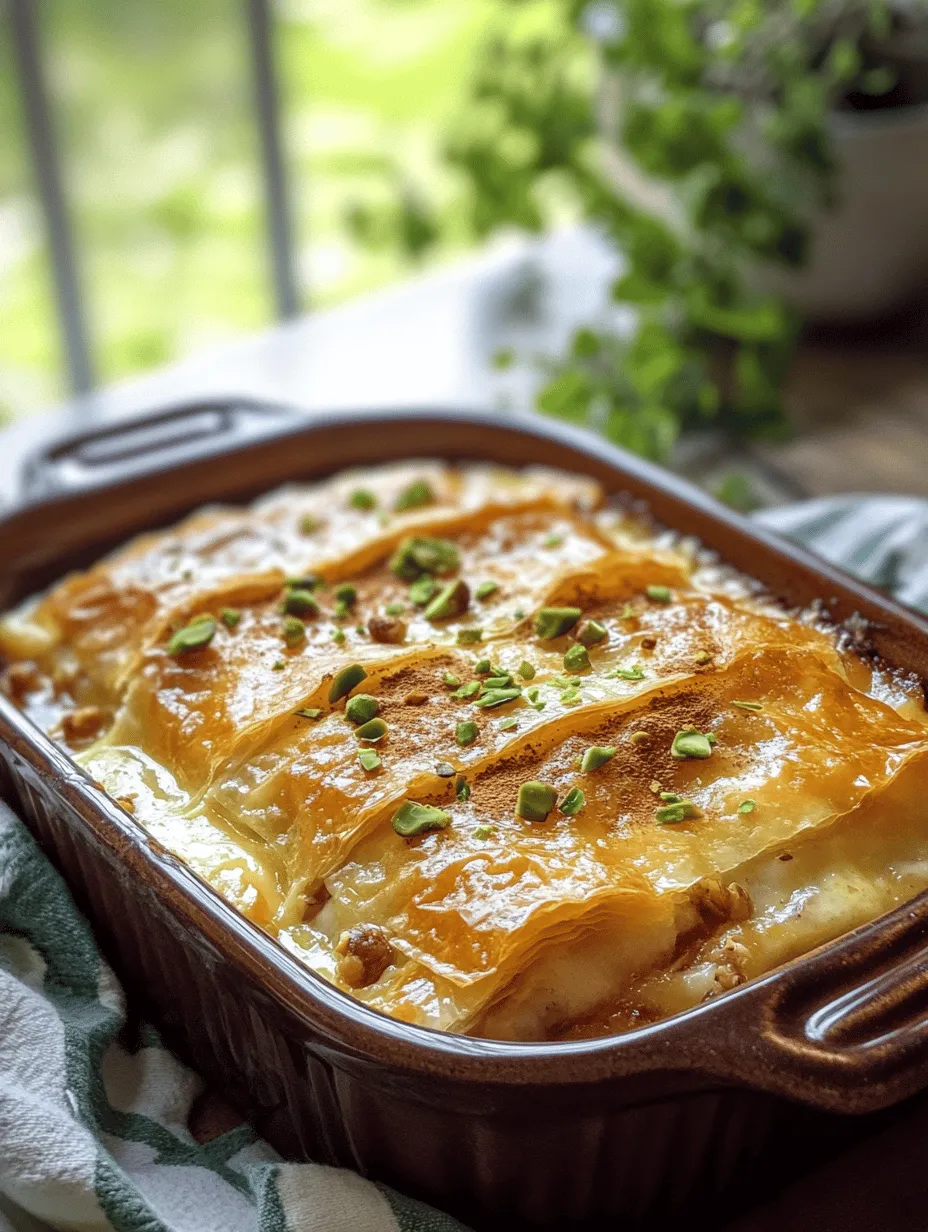Introduction
Baklava is a beloved dessert that has captured the hearts and palates of people across various cultures. This exquisite treat is particularly famous in Middle Eastern and Mediterranean cuisines, where it graces tables during festive occasions and family gatherings. The allure of baklava lies not only in its rich history but also in its delightful texture and flavor profile. Imagine crisp layers of phyllo dough, filled with a luscious mixture of nuts, and drenched in a sweet syrup that brings everything together. It’s a symphony of flavors that offers a sweet indulgence unlike any other.
For many, baklava is synonymous with celebration. Whether served at weddings, religious holidays, or family reunions, this dessert is a crowd-pleaser that often evokes warm memories of shared moments. The process of making baklava at home adds another layer of significance, transforming it from just a dessert into a labor of love. The skillful layering of phyllo, the careful preparation of nuts, and the fragrant syrup all come together in a beautiful display that is sure to impress.
Understanding Baklava
Baklava has deep-rooted historical significance, with origins that trace back to the ancient empires of the Middle East and Mediterranean. Though the exact birthplace of baklava is debated, it is widely believed to have evolved from the ancient Assyrian layers of bread, which were filled with nuts and sweetened with honey. Over centuries, baklava traveled across various regions, adapting to local tastes and customs, ultimately becoming a staple dessert in many cultures, from Greece to Turkey, and beyond.
The beauty of baklava lies in its variety. Different regions boast their own unique takes on this classic dessert. For instance, Greek baklava typically features walnuts, while Turkish baklava often incorporates pistachios or almonds. These variations extend beyond just the nut selection; they encompass differences in syrup sweetness and the spices used to enhance the flavors. Regardless of the style, baklava maintains its cultural significance, often symbolizing hospitality and generosity.
From a nutritional perspective, baklava is an indulgence worth savoring. It primarily consists of phyllo dough, nuts, and a sweet syrup, each ingredient playing a vital role in the overall flavor and texture. Phyllo dough, with its delicate, flaky layers, provides a satisfying crunch, while the nut mixture contributes healthy fats, protein, and a range of vitamins and minerals. The syrup, often made from honey or sugar, adds sweetness and helps to bind the dessert together. While baklava is undoubtedly a treat, it’s essential to enjoy it in moderation, given its calorie-dense nature.
Ingredients Breakdown
Before diving into the preparation of baklava, it’s crucial to understand the ingredients that create this delectable dessert.
Phyllo Dough
The foundation of baklava is its phyllo dough, which is known for its light and crispy texture. Using high-quality phyllo is essential for achieving the best results. When selecting phyllo dough, opt for a brand that is well-made and comes thawed, as this will save you time and frustration in the kitchen. Ensure that your phyllo remains covered with a damp cloth while you work to prevent it from drying out. Dried phyllo can become brittle and crumbly, making it difficult to layer properly.
Mixed Nuts
The filling of baklava is where the magic truly happens. A combination of nuts provides unique flavors and textures that elevate the dessert. Commonly used nuts include walnuts, pistachios, and almonds. Each nut brings its distinct taste: walnuts offer a rich, earthy flavor; pistachios bring a subtle sweetness; and almonds provide a satisfying crunch. When preparing your nut mixture, aim for a balance that complements the overall flavor profile of the baklava. Don’t forget to toast the nuts lightly before chopping them to enhance their flavor.
Sweeteners
The sweet syrup that envelops baklava is a critical element in defining its taste. Traditionally, baklava is sweetened with a syrup made from honey and sugar, which adds depth and richness. Honey provides a floral sweetness that pairs beautifully with the nuts, while sugar contributes a more straightforward sweetness. The choice between honey and sugar can depend on personal preference and availability. Some bakers even opt for a mix of both to achieve a balance of flavors.
Spices
To elevate the flavor of baklava further, spices play an essential role. Cinnamon is a classic addition, offering warmth and a hint of spice that complements the sweetness of the syrup and the richness of the nuts. Vanilla is another common flavoring that adds depth and complexity. A subtle hint of vanilla can enhance the overall experience of eating baklava, making it even more indulgent.
Preparation Steps
Creating baklava may seem daunting at first, but with the right approach and attention to detail, you can master this delightful dessert. Below are the essential preparation steps that will lead you to baklava bliss.
Preheating the Oven
The first step in making perfect baklava is to preheat your oven. This is a crucial step, as the temperature of the oven directly affects the texture of the phyllo dough. Preheat your oven to 350°F (175°C) to ensure an even bake. A properly preheated oven will help the layers of phyllo become golden brown and crispy, creating the ideal contrast with the nut filling and syrup.
Preparing the Nut Mixture
While the oven is preheating, you can start preparing the nut mixture. Begin by selecting your nuts—walnuts, pistachios, and almonds are popular choices. Use a food processor to chop the nuts coarsely; this will help distribute the flavors evenly throughout the baklava. Be cautious not to over-process the nuts, as you want to maintain some texture. Once chopped, mix the nuts with granulated sugar, ground cinnamon, and a pinch of salt. The sugar will enhance the sweetness, while the cinnamon adds warmth, making each bite irresistible.
Layering Phyllo Dough
Layering the phyllo dough is perhaps the most critical step in baklava preparation. Start by removing your thawed phyllo dough from its packaging and unrolling it on a clean surface. Keep the sheets covered with a damp cloth to prevent them from drying out. Using a sharp knife, trim the phyllo sheets to fit your baking dish if necessary.
To begin layering, take one sheet of phyllo and place it in the bottom of your greased baking dish. Brush it lightly with melted butter, taking care to cover the entire surface. This step is vital, as the butter will help achieve that irresistible crispiness. Repeat the process, layering about 8 to 10 sheets of phyllo, brushing each layer with butter.
Once you’ve established a solid base, spread a portion of the nut mixture evenly over the phyllo layers. Then continue layering with more sheets of phyllo, repeating the buttering process and adding nut mixture until all ingredients are used, finishing with several layers of phyllo on top. Aim for a total of around 20-30 sheets, depending on your desired thickness.
As you layer, be gentle and take your time; baklava is a labor of love. Each layer contributes to the final texture, so don’t rush through this step. Once you’ve completed the layering, use a sharp knife to cut the baklava into diamond or square shapes, ensuring that you cut through all layers down to the bottom of the dish. This will help the syrup soak in and make for easier serving later on.
Stay tuned for the next section, where we’ll delve into the baking process and the final steps to achieve perfect baklava!
Assembling the Baklava
When it comes to assembling baklava, the key to a perfect result lies in the layering technique and evenly distributing the nut mixture across each layer. Begin by placing a sheet of phyllo dough on a clean, flat surface and brushing it generously with melted butter. This not only adds flavor but also helps achieve that signature flaky texture.
Best Practices for Layering and Distributing the Nut Mixture:
1. Layering Phyllo Dough: Start with 8-10 sheets of phyllo dough, brushing each layer with melted butter. This ensures that the baklava will be beautifully flaky. Remember to keep the remaining phyllo sheets covered with a damp cloth to prevent them from drying out.
2. Nut Mixture Distribution: Once you’ve laid the first few sheets, it’s time to add your nut mixture. Spread about 1 cup of your finely chopped nuts, combined with sugar and cinnamon, evenly across the phyllo layers. Use a spatula to ensure an even layer without clumps.
3. Repeat the Process: Continue to layer phyllo sheets and nut mixture, typically repeating this process until you have at least three nut layers. Finish with a final layer of phyllo sheets, usually about 8-10, ensuring to butter each one thoroughly.
Cutting Baklava
Once you have fully assembled your baklava, it’s time to cut it into pieces before baking. This step is crucial for achieving clean cuts and ensuring that each piece holds its shape after baking.
Techniques for Scoring the Baklava for Clean Cuts Post-Baking:
1. Scoring the Layers: Using a sharp knife, score the top layers of phyllo into diamond or square shapes. Make sure to cut through the top layers without cutting all the way to the bottom. A depth of about half an inch is sufficient.
2. Creating Uniform Pieces: For even-sized pieces, use a ruler to measure and mark where you’ll cut. This makes it easier to achieve uniform squares or diamonds, giving your baklava a professional look.
Baking the Baklava
Now that your baklava is beautifully assembled and cut, it’s time to bake it to golden perfection.
Baking Tips: Optimal Time and Temperature:
1. Preheat Your Oven: Preheat your oven to 350°F (175°C). This temperature ensures a thorough and even bake, allowing the baklava to become golden brown without burning.
2. Baking Duration: Place the baklava in the preheated oven and bake for approximately 45-55 minutes. Keep a close eye on it during the last 10 minutes, as ovens can vary.
Monitoring for Doneness: Signs That Baklava is Ready to be Removed from the Oven:
1. Golden-Brown Color: The top should be a rich golden-brown, indicating that the phyllo has crisped up beautifully.
2. Aroma: You should also be able to smell a warm, nutty aroma wafting through your kitchen, which is a good indicator that the baklava is ready.
Making the Syrup
While the baklava bakes, you can prepare the syrup, which will enhance the dessert with sweetness and moisture.
Syrup Preparation: The Science Behind Combining Sugar, Honey, and Water:
1. Combine Ingredients: In a saucepan, combine equal parts sugar and water (typically 1 cup each), along with ½ cup of honey. This blend creates a syrup that’s both sweet and rich, thanks to the honey’s unique flavor.
2. Add Flavorings: For added depth, consider including a splash of lemon juice and a cinnamon stick while the syrup simmers. These elements will balance the sweetness.
3. Simmering the Syrup: Heat the mixture over medium heat until the sugar dissolves, then bring it to a gentle boil. Reduce the heat and let it simmer for about 10 minutes, stirring occasionally.
Cooling the Syrup: Why It’s Crucial to Let the Syrup Cool Before Applying It to Hot Baklava:
1. Temperature Difference: Allow the syrup to cool for at least 15-20 minutes. Pouring hot syrup over hot baklava can make it overly soggy. The contrast in temperature will allow the syrup to soak in perfectly without compromising the texture.
Combining Baklava and Syrup
Now that both the baklava and syrup are ready, it’s time to combine them for that ultimate baklava experience.
Techniques for Pouring Syrup: Ensuring Even Distribution to Avoid Sogginess:
1. Drizzle Method: Once the baklava is out of the oven, carefully pour the cooled syrup over the hot baklava. Start from the edges and work your way toward the center, ensuring that each piece gets its share of syrup.
2. Avoiding Pools of Syrup: To prevent sogginess, avoid pouring too much syrup in one spot. An even drizzle ensures that each layer is coated without overwhelming it.
Importance of Resting Time: How Letting Baklava Sit Helps Develop Flavor and Texture:
1. Resting Period: Allow the baklava to rest for at least 4 hours, but ideally overnight. This resting time allows the syrup to fully soak into the layers, intensifying the flavor and improving the texture.
Serving Suggestions
With your baklava perfectly assembled, baked, and soaked in syrup, it’s time to serve!
Presentation Ideas: How to Serve Baklava Elegantly for Gatherings:
1. Plating: Arrange the baklava pieces on a decorative platter or cake stand. You can garnish with a sprinkle of crushed nuts or a dusting of powdered sugar for added visual appeal.
2. Individual Serving: For a more personal touch, consider serving each piece on small plates with a dollop of whipped cream or a side of Greek yogurt, which complements the sweetness.
Pairing Recommendations: Beverages and Dishes That Complement Baklava’s Rich Taste:
1. Beverages: Baklava pairs wonderfully with an array of beverages. Traditional options include Turkish coffee or mint tea, both of which enhance the nutty flavors. If you prefer something chilled, a sweet dessert wine or lightly brewed herbal tea works well too.
2. Side Dishes: Serve baklava alongside a fresh fruit salad or a light yogurt dip to balance the richness. The acidity of fresh fruits or yogurt complements the sweetness of baklava beautifully.
Storage Tips: Best Practices for Storing Baklava to Maintain Its Crispness:
1. Proper Storage: Store baklava in an airtight container at room temperature. Make sure it’s completely cooled before covering to prevent moisture buildup.
2. Avoid Refrigeration: While it may be tempting to refrigerate baklava, this can lead to sogginess. Instead, keep it in a cool, dry place, where it can remain fresh for up to two weeks.
Conclusion
Baklava stands out as a timeless dessert, beloved in many cultures around the world. Its rich history can be traced back to the Ottoman Empire, where it was often served at celebrations and gatherings. This sweet indulgence, layered with flaky phyllo, nuts, and honey syrup, has won the hearts of many and continues to be a cherished treat.
Encouraging readers to try making baklava at home opens up a world of culinary exploration. The process, while detailed, is rewarding and allows for personal touches to be added along the way. Each bite of homemade baklava not only reflects the effort put into it but also the joy of sharing a traditional dessert with loved ones.
In essence, the experience of crafting and sharing homemade baklava brings people together, celebrating both history and flavor in every delicious piece. So gather your ingredients, follow the steps, and enjoy the sweet bliss of baklava!



